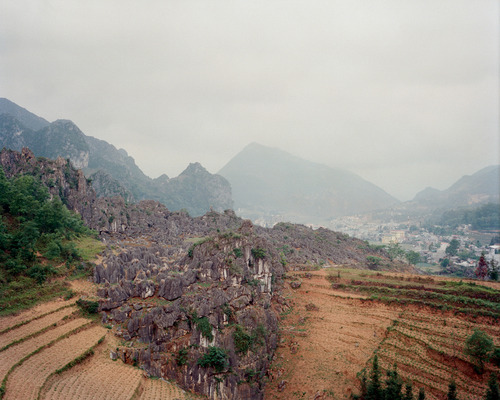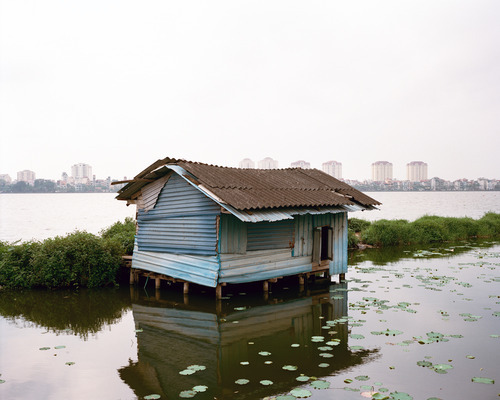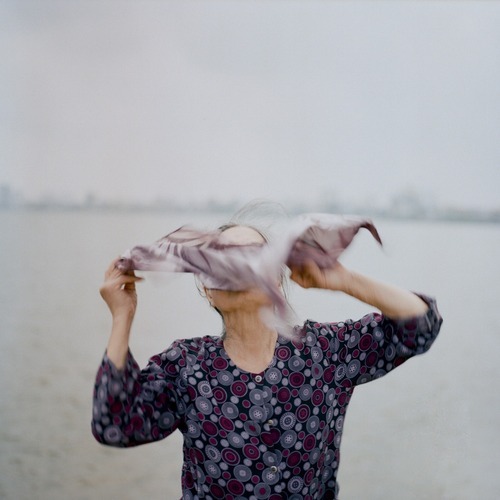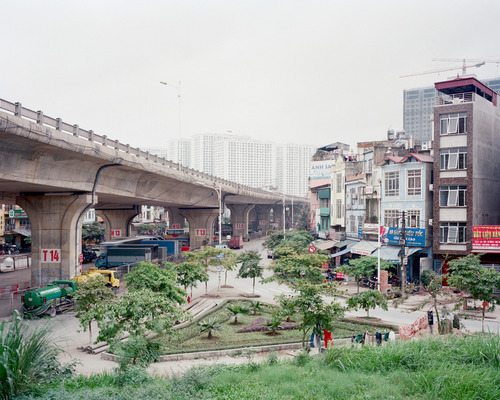What are your earliest memories of the relationship with photography?
Gianpaolo Arena (GA): The first photographic memories coincide with my personal visual memory. I am very far away, inaccurate, out of focus. Innocent, pure, emotional. The first album of family photographs, pictures of grandparents on the walls, those of my family on documents and passports. The first seeds of the construction of a nascent personal visual grammar and selective formation of taste and style.
How has this relationship evolved over time, and at what point are you today?
GA: Subsequently, things have changed a lot through the academic training in architecture, the visual culture fueled by photo books and direct relationships with the Italian and international masters of photography. With time everything changes. Today photography is to me so many things together: a profession, with all its rewards and annoyances, a challenging and interesting research and a passion, alive and exciting.
The pleasure of surprise always feeds my intellectual curiosity. Today I find myself as at the beginning of my path, feeding an unchanged desire to learn, to discover new, exciting, and surprising things. Citing Marcel Proust: «The real voyage of discovery consists not in seeking new landscapes, but in having new eyes».

© Gianpaolo Arena - Ha Giang, Vietnam, 2014
Can you introduce us to your project ‘My Vietnam’. How have you developed this work? Tell us also of the publishing project you’re working on?
GA: The photographic project was born from a trip of 30 days in Vietnam. Venice - Ho Chi Minh extremes of a journey. My cultural imagination had formed with the tragedies of war films, by the images and visions of Coppola, Stone, or Kubrick up to the most recent Tran Ahn Hung. My Vietnam was very different, a trip across the country, steeped in the personal, beyond stereotypes. I found a welcoming country, open and intriguing. Greatly enigmatic and mysterious. A door to the Orient.
Many pressures towards modernity, with so much positive energy and a lot of contradictions. I remember very intensively an episode… I spent the first night in Ho Chi Minh City in the heart of the ancient city, where the houses are stratified and where they find space as they can.
It was late at night but I could not close my eyes a bit for Jet Lag and a bit for the deafening noise of traffic and the music coming from a room at the base of the building of my hotel. Suddenly, after hours of junk music, I recognized immediately “Go Bang” by Dinosaur J in the remix of François Kevorkian, with its syncopated and spastic rhythms and its BANG, BANG, BANG. Epiphanic apparition! In those moments the former Saigon seemed New York, plus the colored and 'sweaty’ neon, the sticky and clammy air and the sweetish Eastern atmosphere. A window to explore alien territory with new eyes.
The difference between the little that I knew before, and all that I have seen, lived and that excited me later, formed the main body of my photographic work. In part, my approach was documentary, part travelogue and, to a lesser extent, a narrative description. Coming back after a year having gained the experience, depth readings, and new visions, had a different meaning. The desire was to try to finish what I had started. The look was different, the search was more targeted, the reasons were more accurate. I have gone to the extreme border of China, crossing the mountainous region of HA Giang. The material produced in a total of two months of time is equal to 100 rolls of film in medium format. Hence the work of selection and editing developed in several months with the idea of building my publication on the topic. From the wilderness and desert areas liminal to the urban textures, from the great empty silent to chaotic urban densities.

© Gianpaolo Arena - Ha Giang, Vietnam, 2014
I am looking for an international publisher able to believe in this type of project and to make the best of what was produced in 3 years of research. Part of the work was presented at the Fondazione Fabbri, Villa Brandolini, Pieve di Soligo, TV, within the festival “F4 - An Idea of Photography” by Carlo Sala, then in Rome by Camilla Boemio at Galleria Anteprima d’Arte Contemporanea and during the International Festival of Rome at Macro - Museum of Contemporary Art, where it is on display until 11 January 2015. A good representation of the latest new images is available in this interview and on this blog, curated in collaboration with Camilla Boemio.
Tell me about a place that you would like to photograph sooner or later?
GA: They are many. All those where I’ve never been. Greenland, Patagonia, Mexico, Cambodia, Japan, China, Nepal, the Caucasian territories of Azerbaijan… For their possible future developments in different fields I find interesting the exponential growth of suburbia and the improper forms of environmental resistance and ecological resilience in place. The most frequent question I ask myself is: how the medium of photography is important in giving us the ability and the knowledge to decipher our relationship with the contemporary world?
You are one of the founders of Landscape Stories, online magazine of photography. Why was this experience started, and how has it evolved?
GA: The magazine was founded by the ideas and discussions of three friends to see something that was not there yet. Landscape Stories grows and develops with a new approach, open and interdisciplinary. With Claudio Bettio and Andrea Gaio we decided to present a series of thematic proposals, which could involve in addition to photography also literature, art, music, cinema, architecture, following only our elective and editorials preferences. Quotes, references and tracks become red wires functional to the development of the narrative. A story in pictures in the form of collection, accompanied by an editorial and extracts from literary texts that reinforce the theme and help to frame the cultural climate in which the photographic project develops. Currently, after 18 monographs, we published in the pages of Landscape Stories, through magazines, directories, forums and social networks, thousands of photo projects and editorials. Among others, we presented the following international authors: Thomas Stuth (Germany), Mitch Epstein (U.S.A.), Nadav Kander (U.K.), Roger Ballen (U.S.A.), Alec Soth (U.S.A.), Guido Guidi (Italy), Larry Sultan (U.S.A.), Michael Wolf (Germany), Frank Gohlke (U.S.A.), Jem Southam (U.K.), J H Engstrom (Sweden), Adam Bartos (U.S.A.), Mona Kuhn (Brazil), An-My Lê (Vietnam), Mark Steinmetz (U.S.A.), Joachim Schmid (Germany), John Gossage (U.S.A.), Massimo Vitali (Italy), Mike Brodie (U.S.A.), Raimond Wouda (Netherlands), Raymond Meeks (U.S.A.). Among the featured interviews: Axel Hutte (Germany), Richard Rothman (U.S.A.), Simon Roberts (U.K.), Olivo Barbieri (Italy), Hiroshi Watanabe (Japan), Lise Sarfati (U.S.A.), Ferit Kuyas (Turkey), Francesco Jodice (Italy), Peter Brown (U.S.A.), Max Pam (Australia), Spencer Tunick (U.S.A.), Karin Apollonia Muller (Germany), Valerio Spada (Italy), Hans-Christian Schink (Germany), Doug Dubois (U.S.A.).

© Gianpaolo Arena - Hanoi, Vietnam, 2014
Is there a number of Landscape Stories that you’re more connected with or that you want to tell?
GA: I am bound to each issue of the magazine, really. Each selection monographic was born in a different way and is designed and developed long before. Sometimes the red wire is dictated by literary texts, most often by the quality and quantity of photo projects. Those who remember more, for the strength of the theme, are: LS 07 | TREES, LS 09 | ADOLESCENCE, LS 12 | RIVER, LS 15 | MOUNTAINS. The last LS 18 | FAMILY has involved an extraordinary sequence of authors, among others: Trish Morrissey, Thomas Struth, Doug Dubois, Sage Sohier, Larry Sultan, Laura McPhee, Joanna Piotrowska, Leonie Hampton, Alex Cretey-Systermans, Bertien van Manen, Nicolai Howalt, Alain Laboile, Raymond Meeks, Susan Worsham, Fred Huening, Petra Stavast, Lesly Deschler Canossi, Martin + Lindsay, Seba Kurtis, Julian Germain…
Through Landscape Stories you also worked on educational activities, in particular workshops. This way you met important photographers and especially many people eager to improve themselves and to confront. What lessons you learned from this experience? Of all the photographers who surprised you the most?
GA: The organization of the workshop, organized together with Giorgia Sarra, are an important reality for the exchange of ideas and discussion on photography, today and tomorrow. The last, curated with Tre Terzi, Vincenzo Castella, Simon Roberts, Francesco Jodice, Raimond Wouda, between Venice and the Dolomites, places of excellence where you are surrounded by the beauty and Sublime, accounted for the extraordinary opportunities for debate and discussion between talented photographers from all over Europe. I have learned from each experience different things, each in its own way precious and unrepeatable. The greatest wealth lies in human and professional exchange, and hence the seeds for the cultural growth of tomorrow are thrown. Humanity, passion, generosity and energy of teachers as the opening, the interest, the desire to get involved and the curiosity of the participants have been surprising. Some memorable episode … talk to Francesco Jodice and find that we are both fanatics of Italian detective films by Fernando Di Leo and Enzo Castellari. Feel Vincenzo Castella remember his relationship with Luigi Ghirri and Lewis Baltz or tell the blues of the Mississippi Delta and the field recordings of Alan Lomax.

© Gianpaolo Arena - Hanoi, Vietnam, 2014
In addition to photography you are a big fan of music. Urbanautica houses successfully your editorial 'Undercover’. It’s extraordinary the bond that over time has united influential photographers with bands and songwriters. An example for all William Eggleston who is also musician. How did you get to this?
GA: I am a curious, passionate and 'omnivorous’ music consumers since I was a teenager. My discography has 10,000 albums but curiosity about the origin and transmission of sound remains an irresistible attractor. Of course the interest and love for alternative musics were vehicles for introducing me to different cultures and worlds. Seminal experiences generate insights in all art forms. Undercover allows me to make room for these plots, indicate paths, suggest hypotheses. William Eggleston, among others, weaves his name with those of Big Star, Alex Chilton, Primal Scream, Chuck Prophet, Silver Jews, Joanna Newsom.
I like to think that the glossy perception of the color and light of the American master favors somehow a special joyous musicality where the irrational chaos of things magically takes shape and becomes accomplished. One of the insights that I would like to do next on 'Undercover’ is on the covers of the albums and aesthetics of a musician, not a photographer, always shrouded in mystery and existential hermitage, Jandek. All of his albums, published by his own label 'Corwood Industries’, describe in the blurry covers indistinct faces and shadows, details of a house in suburban Texas or musical instruments. A thick visual and audio corpus, monotonous, disturbing. A poor poetic to describe a disturbing and obsessive microcosm.
Of course the incestuous relationships between photography and the arts are numerous, promiscuous and indefinite. Think about how the cinematic visions have influenced the work of photographers and vice versa. I think of Wim Wenders, Werner Herzog or Godard. In other fields: Jeff Keen, Harry Smith and Kenneth Anger. We could go on forever and continue to shuffle the cards. In this regard, there are two phrases indicative «You have to listen to the eye before looking» - Jean-Luc Godard and «I talk in pictures, not in words» - Peter Gabriel.
One of your recent projects is CALAMITA/À. An initiative that is gathering a large interest and a number of significant photographic contributions.
GA: The project in its editorial format, and design exhibition is curated by Marina Caneveand Gianpaolo Arena. Photography is the medium of choice to investigate the urban landscape and identity of the northeast Italian. Art, sociology, urban planning and photography combine to define the identity of the territory with a multidisciplinary open approach. CALAMITA/À aims to ensure that the area in question will become a laboratory and a privileged place of observation. The platform was created as a tool of territorial investigation, which through a planned research, wants to deepen the ongoing changes, to generate debate, to revealing and critical points of view, to attract interest and knowledge around a nodal place still to be defined, that of Vajont.
The wave of the October 9, 1963 suddenly marks an instantaneous and irreversible change in the landscape. The catastrophic event clears places, memories and destinies. The identity of these places were wiped out, leaving room for a new and chaotic urban layout. The morphology of the territory, the topography, infrastructure networks, the architecture, the social context are some of the subjects of analysis examined. Currently about 50 authors with different scopes are involved. Artists, writers, musicians, graphic designers, filmmakers are developing their own site-specific project. An important role is played by the residents and those who live on the territory, with their experience and their experiential memory.
An important part comes from the new editorial 'Collateral’ which currently houses the works of international photographers like Céline Clanet, Richard Petit, Bärbel Praun, François Deladerriere, Yannik Willing, Pascal Amoyel, Pétur Thomsen. The section devoted to interviews issues will become increasingly influential. The interviews are designed as insights and windows on the world and have as their object: the catastrophe and calamity, the territorial and urban changes, mutant identities, geopolitics, climate change, the global market, the architecture, the tourism industry, ecological issues, migration and social marginality, minorities.

© Gianpaolo Arena - Hanoi, Vietnam, 2014
Could you name three books of photography that you are very fond of?
GA: 'Early Color’ by Saul Leiter '. The Democratic Forest’ by William Eggleston. 'Hidden Islam’ by Nikolaus Degiorgis. And here you can find 10 other books.
What are your plans for the future?
GA: The launch of the new monograph of Joël Tettamanti “Works 2001-2019”, where I wrote an essay. The book was published by the Swiss Benteli Verlag in various editions and the graphics design by Onlab. The first months of 2015 I will be part of a couple of juries of international photography awards. In February, with Landscape Stories I will participate on the exhibition of Italian photographic publishers at 21er Haus, a new contemporary art space in Vienna. From March 2015 the programming of new workshops will bring LS to collaborate with numerous international photographers.
I will continue to curate the projects 'My Vietnam’ and 'CALAMITA/À’ and trying to accomplish the editorial publications for both. An editorial collaboration dedicated to Australia, between Landscape Stories and Heidi Romano and Photobook Melbourne Festival, will see the light in the coming months. And of course the new issues of the magazine, new interviews and the new editorial Dream books and Books reviews.
In the immediate to find, buy and listen to the box of 44 CDs of Glenn Gould: 'The Complete Original Jacket Collection’. Reading the full interview on the 'Abecedario’ by Gilles Deleuze, the complete set 'Heimat’ by Edgar Reitz and 'La Jetée’ by Chris Marker… The end is just a new beginning.
---
LINKS
Gianpaolo Arena
Italy
share this page
